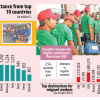Remittance jumps 32% in May

Bangladesh recorded a sharp rise in remittance inflows in May, as migrant workers sent more money home in the run-up to Eid-ul-Azha, which falls in early June.
Funds sent by migrant workers and non-resident Bangladeshis reached $2.97 billion last month, up 32 percent from the same period a year earlier, according to data released by the Bangladesh Bank yesterday.
With May's receipts included, total remittance inflows for the first 11 months of the current fiscal year, which began in July, have grown by 29 percent to 27.5 billion.
In comparison, the country received $21.37 billion during the same period last year.
Analysts see the steady rise as a reflection of growing confidence among migrant workers in using formal banking channels, especially in the lead-up to Eid-ul-Azha. Exchange rate incentives have also played a part.
With May's receipts, total remittance inflows for the first 11 months of the current fiscal year reached 27.5 billion
Meanwhile, economists and bankers point to several drivers behind the surge, including a 2.5 percent government incentive for sending money through official channels, a stronger push from banks, greater exchange rate stability and a decline in the use of illegal money transfer networks.
Md Shaheen Iqbal, deputy managing director & head of Treasury & Financial Institution at BRAC Bank, said banks are increasingly delivering remittances through digital channels to speed up the process.
He added that banks have also introduced incentives for migrant workers, such as gifts, insurance coverage and loans tied to remittance amounts. These perks are helping to steer remitters away from informal routes such as hundi and hawla.
Birupaksha Paul, professor of economics at the State University of New York, said the recent shift towards a market-based exchange rate has made a key difference.
"The exchange rate of the US dollar is now nearly market-based, allowing remitters to receive a better price — one of the key reasons behind the increased inflow in May," he said.
Although the Bangladesh Bank removed the fixed exchange rate under pressure from the International Monetary Fund (IMF), Paul believes the move was ultimately beneficial.
Paul, a former chief economist at the central bank, said remittance flows have been boosted by a clampdown on informal transactions, especially through measures targeting money laundering.
"This shift is not due to patriotism. Remitters are choosing formal channels mainly for economic reasons.
They are simply getting better value for their money," he said.
Selim Raihan, a professor of economics at the University of Dhaka and executive director of the South Asian Network on Economic Modeling (Sanem), said that migrant workers often send more money during difficult times, such as when inflation is high or wages stagnate.
The latest rise in remittances, he said, is welcome news and could ease pressure on the country's foreign exchange reserves.
"But we need to be careful not to misinterpret it as a sustainable shift," said the economist.
He said there is usually an increase in inflows ahead of Eid, but such seasonal spikes should not be mistaken for lasting growth.
"Remittance flows are highly volatile," he said. "Periods of growth are often followed by sharp declines, so policymaking must consider this reality."
Paul estimates that total remittances for the fiscal year could reach $31.5 billion if the current trend holds.

 For all latest news, follow The Daily Star's Google News channel.
For all latest news, follow The Daily Star's Google News channel. 









Comments